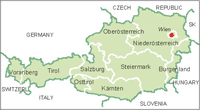
Settlments
 Mondsee & the Mondseeland
Mondsee & the Mondseeland
One of the prettiest towns in the Upper Austrian part of the Salzkammergut - and one of the most touristy ones - Mondsee is easy to get to by car from Salzburg and a popular destination for day-trip tourists of which dozens of busses float into the town every day during the main season.
Historically, Mondsee is ancient: Some of the Neolithic finds that were discovered in the bay are displayed in the park by the promenade, others in the town museum. The local community gave the name "Mondsee culture" to this school of Neolithic life in the Salzkammergut, showing the importance of the settlement. In the 6th century, Bavarians started to populate the region and through the spiritual centre of Salzburg, a monastery was founded 748 (making it the oldest of Austria until Salzburg lost its independence).
In 1506, Mondsee became part of the Habsburg′s growing portfolio of possessions. In case you wonder why on earth a small town (a village, really) needs such a big church as St Michael in Mondsee, here is the reason: Because it was part of one of Austria′s most significant monasteries.
The interiors of St Michael have featured in the wedding scenes of "The Sound of Music". A less-known, but more significant contribution to the history of art are the thirteen Baroque side-altars, of which seven were made by the famous Swiss artist Meinrad Guggenbichler who spent most of his career with the abbey′s church. The courts of the monastery are now used as a hotel and conference centre, but you are free to walk around a bit - there is also a Heimatmuseum (town museum) in the building, in which the most interesting pieces on display deal with the role of the local settlement in the Neolithic Salzkammergut.
 Hallstatt, Pearl of the Salzkammergut
Hallstatt, Pearl of the Salzkammergut
Hallstatt is many things: the prettiest village in the entire Salzkammergut; the oldest town of Austria ; a UNESCO World Cultural Heritage Site (or at least part of it); and one of Austria′s premier tourist attractions. The belly button of the Salzkammergut is located by the Lake Hallstattersee, itself among the most beautiful lakes of Austria, with steep, forested mountains rising on its sides.The mighty Mount Dachstein is visible from the lake and the Sechserkogel range makes you understand that you are properly within an alpine landscape.
Hallstatt was the centre of a Neolithic culture that derived its success from the nearby salt mines. This culture, named "Hallstatt Culture" after the town, dominated the area north of the Alps until the arrival of Celtic tribes. Their artefacts have been found outside of today′s Austria, in Hungary and the Mediterranean.
The prime time of Neolithic Hallstatt lied in the three centuries between 800 and 500 BC. However, the success of the city continued to flourish after a possible low during Roman and early medieval times. Later in the Middle Ages, Hallstatt became once again one of the most important centres of salt mining and trade in Central Europe.
Hallstatt had one significant problem, though: it was awfully difficult to access. Until well into the 19th century, no major roads led to the village and visits from outside were rare. The first road to Hallstatt was built only in 1890! The narrow ground between cliffs and lake supported only a small community, and the lack of space gave rise to some very specific attractions.
 Bad Ischl: Imperial core of the Salzkammergut
Bad Ischl: Imperial core of the Salzkammergut
At only 468 m altitude Bad Ischl with its 13.887 inhabitants combines noble tradition with fresh zest for life. Located by a mountain, by a river and near several skiing areas and lakes tourists can choose what to do: make a trip with a cablecar, visit the Emperor's Villa, the Salt Mine, the Operetta Festival or the Salzkammergut Gulf Club. Play at tennis courts, explore hiking or cycling tracks.
A prosperous trading centre for salt for centuries, Bad Ischl became the best-known health resort of the Salzkammergut region when a local doctor named Josef Gorz discovered, in the early 19th century, that the saline from the nearby mines helped to treat and even cure rheumatic disorders. The news spread quickly, probably accelerated through the pan-European craze about spas of these days and quickly the Viennese aristocracy developed a keen interest in the salty waters of Bad Ischl. Composers like Lehar, Strauss, Bruckner and Brahms discovered their passion for Bad Ischl - Lehar even moved there. Think of the romantic, melodic aspects that the music of these four composers have in common and you can anticipate the spirit of Bad Ischl. Spa concerts and other musical performances are just some of the many cultural delights offered at the foot of the 1450 high Katrin mountain.
 Back to top
Back to top


 Romana
Romana English
English











